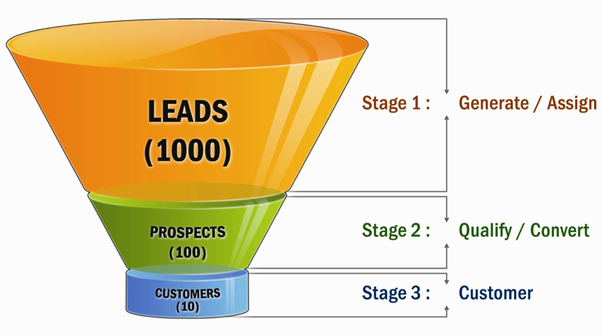How Does A Marketing Funnel Work?
Picture the wide top of a funnel. This is where a large number of people might become aware of your products or services.
All these people are your leads, or potential customers. As they move through your funnel towards the much narrower neck, many will drop off. A much smaller number of leads will actually make it through the entire funnel.
The purpose of the funnel is to convert as many leads as possible into actual customers who are willing to pay for your products or services.
Traditional Sales Funnel
The traditional sales funnel has three broad stages:- Awareness – when a lead first discovers your brand
- Evaluation – when a qualified lead (or prospect) decides to find out whether your product or service is the right fit or not
- Purchase – when the prospect gathers the last bit of information they need before deciding to buy and becomes a customer (the stage every business wants to achieve!)
Content Marketing Funnel
The generic content marketing funnel is similar, but has a fourth broad stage:
- Attract – when a lead first discovers your brand
- Convert – when a lead likes what they see and becomes a prospect
- Close – when a prospect makes a commitment and becomes a customer
- Delight – when a loyal customer is so satisfied that they become a brand advocate
The great thing about content marketing is that it can help your business reach users at any stage of this funnel, whether they’re at the top or floating somewhere in the middle. And as leads continue to interact with your business, and your business produces more quality content, you’ll widen the neck of the funnel.
What Content Type Goes Where?
Now for the burning question every marketer wants answered: What kind of content belongs at which stage?Here’s the expanded four-stage content marketing funnel with different examples of content that is ideal for each of the four stages:
1. Attract
- Ads
- Landing Pages
- Website
- Videos (Explainer or Product Demo)
- Infographics
- Handy Checklists
2. Convert
- Social Media
- Blog Posts (How Tos or Guides)
- Whitepapers/E-books
- Case Studies
- Webinars
3. Close
- Ratings & Reviews
- Questionnaires
- Self-Assessments
- E-mails
4. Delight
- Surveys
- Special Offers
- Contests & Giveaways
- E-mails
- Social Media
- Blog Posts
- Whitepapers/E-books
I want to be very clear that this is just our map for content types - there is no real consensus on what types of content work best in each stage because it depends a lot on your sales cycle, your industry, and your audience. There is also a lot of overlap between content types and stages.
That being said, this is the best we’ve figured out for now, and it holds true for the vast majority of companies with successful content marketing campaigns.

Comments
Post a Comment